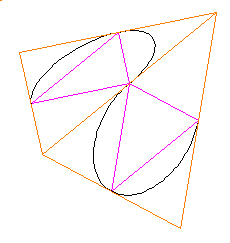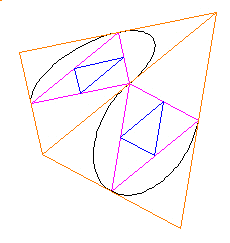
Here is an illustraction of the pattern on a tetrahedron. Only 2 faces of the tetrahedron are shown so that you can easily see the path of the pattern on these two triangular faces.

Note that the tetrahedron faces have been divided into 4 triangles each. The center triangle is colored pink.
We can divide this pink triangle into 4 smaller triangles by dividing each of the pink triangle's edges in half. The resulting smaller triangle is drawn in blue.

Now, when we follow the pattern's path and we get to the mid-edge point of the largest triangle (in orange) there is an octahedron vertex. This is a junction point from which the path goes from one of the tetrahedron's faces to another.
At this point, the pattern may divide itself into two smaller patterns. One smaller pattern remains on the "current" tetrahedrn face while the other smaller pattern switches to the next tetrahedron face.

When we remember that what is shown here is only one tetrahedron taken out of the IVM, we find that there are other possible directions for the path of the pattern to take when it reaches a junction vertex.

Perhaps the reverse is possible as well. That is, two "patterns" may come together to form a larger pattern.
"Multiplication only by division." -- R. Buckminster Fuller
Usage Note: My work is copyrighted. You may use my work but you may not include my work, or parts of it, in any for-profit project without my consent.